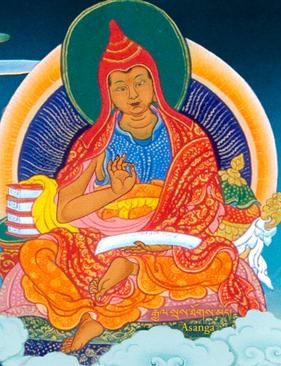Asanga: Difference between revisions
Jump to navigation
Jump to search
No edit summary |
|||
| Line 1: | Line 1: | ||
[[Image:Asanga.JPG|frame|'''Asanga''']] | [[Image:Asanga.JPG|frame|'''Asanga''']] | ||
'''Asanga''' (Tib. Tokmé; ''thogs med'') - One of the most famous Indian saints, he lived in the fourth century. He received teachings from [[Maitreya]] and transcribed them as the ‘[[Five Treatises of Maitreya]]’. Together with Asanga's own commentaries, these texts became the basis for the philosophical schools known as [[Yogachara]], or [[Chittamatra]]. See the story of Asanga in ''The Tibetan Book of Living and Dying'', pages 125-126. | '''Asanga''' (Skt. Asaṅga, Tib. Tokmé; ''thogs med'') - One of the most famous Indian saints, he lived in the fourth century. He received teachings from [[Maitreya]] and transcribed them as the ‘[[Five Treatises of Maitreya]]’. Together with Asanga's own commentaries, these texts became the basis for the philosophical schools known as [[Yogachara]], or [[Chittamatra]]. See the story of Asanga in ''The Tibetan Book of Living and Dying'', pages 125-126. | ||
==His Writings== | ==His Writings== | ||
Revision as of 15:44, 15 July 2008

Asanga (Skt. Asaṅga, Tib. Tokmé; thogs med) - One of the most famous Indian saints, he lived in the fourth century. He received teachings from Maitreya and transcribed them as the ‘Five Treatises of Maitreya’. Together with Asanga's own commentaries, these texts became the basis for the philosophical schools known as Yogachara, or Chittamatra. See the story of Asanga in The Tibetan Book of Living and Dying, pages 125-126.